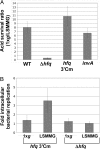Space flight alters bacterial gene expression and virulence and reveals a role for global regulator Hfq
- PMID: 17901201
- PMCID: PMC2042201
- DOI: 10.1073/pnas.0707155104
Space flight alters bacterial gene expression and virulence and reveals a role for global regulator Hfq
Abstract
A comprehensive analysis of both the molecular genetic and phenotypic responses of any organism to the space flight environment has never been accomplished because of significant technological and logistical hurdles. Moreover, the effects of space flight on microbial pathogenicity and associated infectious disease risks have not been studied. The bacterial pathogen Salmonella typhimurium was grown aboard Space Shuttle mission STS-115 and compared with identical ground control cultures. Global microarray and proteomic analyses revealed that 167 transcripts and 73 proteins changed expression with the conserved RNA-binding protein Hfq identified as a likely global regulator involved in the response to this environment. Hfq involvement was confirmed with a ground-based microgravity culture model. Space flight samples exhibited enhanced virulence in a murine infection model and extracellular matrix accumulation consistent with a biofilm. Strategies to target Hfq and related regulators could potentially decrease infectious disease risks during space flight missions and provide novel therapeutic options on Earth.
Conflict of interest statement
The authors declare no conflict of interest.
Figures


References
Publication types
MeSH terms
Substances
Associated data
- Actions
Grants and funding
LinkOut - more resources
Full Text Sources
Molecular Biology Databases

